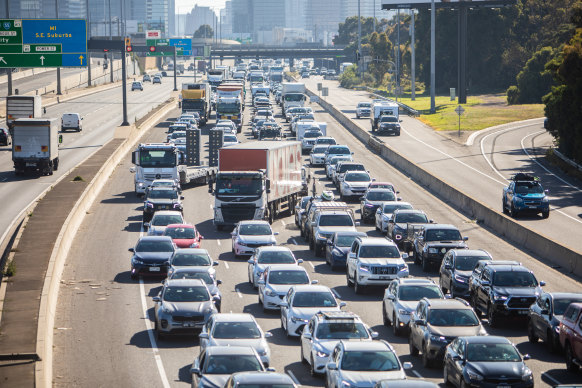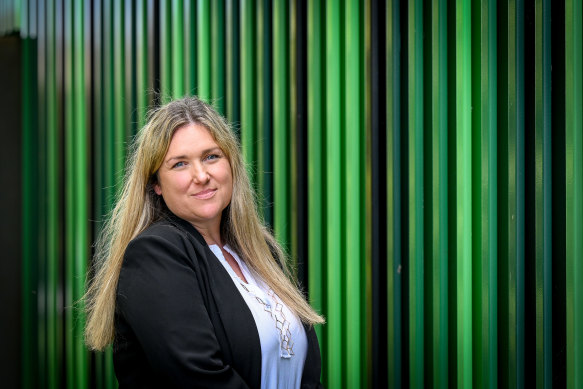Putting all new state government jobs into five suburban hubs around metropolitan Melbourne would generate more than $27 billion dollars in productivity, transport and amenity benefits over the next 30 years, new analysis shows.
Prominent planning firm SGS Consultancy will on Friday release a new economic analysis of how Melbourne’s transport networks and local suburbs would benefit if all new jobs in the Victorian public service were located in or around Monash University, Dandenong, La Trobe University, Sunshine or Werribee.

Decentralising new public sector jobs would counter mounting congestion, according to a new SGS report.Credit: Scott McNaughton
Various suburban centres have long been earmarked in the state’s planning blueprint Plan Melbourne to become decentralised cities outside the CBD including Monash, Dandenong, Werribee, La Trobe, Sunshine, Fishermans Bend, Frankston, Sunshine, Epping, Broadmeadows, Fountain Gate, Dandenong, Box Hill and Ringwood.
The SGS analysis, commissioned by a group of councils in Melbourne’s greater south-east, modelled a scenario where just five of those hubs – Monash, Dandenong, La Trobe, Sunshine or Werribee – absorbed all new public sector jobs over the next 30 years
The analysis assumes that for every public service job located in a suburban area, another two private sector jobs would follow, and as a result about 58,000 jobs (19,000 public and 38,000 private) would be diverted away from central Melbourne over the three decades – or the equivalent of 37 per cent of all jobs in the CBD currently.
There would be $22.4 billion in productivity benefits, $3.94 billion in transport benefits and $1.01 billion in amenity benefits, report co-author William Boadle said.
“If you do relocate some government-based jobs into these areas, we’re not just talking about reduced commute times for workers, but there’s also shorter travel distances for a lot of the existing residents in these suburban areas who will get to access new services locally,” he said.
“There will be more hospitality and retail offerings, the amenity of an area increases. There’s more attractiveness of that area for local residents.”
While the trend of working from home post-pandemic had somewhat lessened the strain on the transport network into the CBD, Melbourne remained a ‘monocentric’ city, meaning the city still had only one main urban centre.
There was a strong case to move towards a ‘polycentric’ city – a city with several urban centres – as this would boost the economic productivity per person in suburban areas and create more thriving hubs outside central Melbourne.
“Work from home addresses some of the problems of a monocentric city, but it doesn’t necessarily deliver the benefits of a polycentric city,” Boadle said.
Jago Dodson, director of RMIT’s Centre for Urban Research, said the state government’s own workforce was one of the relatively few “levers” it had to guide where jobs should be placed in Melbourne. It made sense to look at decentralisation to bolster the state government’s recently announced ambition to build 800,000 new homes over the next 10 years, he said.
“Really, in the centre of the city where the parliament is, all that’s really needed is the executive function of government agencies but all the back office processing type jobs do not need to be in the CBD,” he said.
“So people who work in [areas like] alcohol licensing, driving licensing – all those basic frontline regulatory functions of state government do not need to be in the CBD.”
Some state government services have already been successfully decentralised, including the Transport Accident Commission, which moved to Geelong in 2009, and WorkSafe, in 2018.
But Dodson said there were obvious challenges to decentralising to urban hubs; including that suburbs would remain car-dependent unless there was a major public or bike transport investment, and a ‘cultural’ preference for large stand-alone homes that could see people take up jobs in urban hubs but remain living – and commuting from – even further out.
“It’s a good idea to reduce the pressure on the commuting system and housing around the CBD, but it’s not a simple question to resolve,” he said.
Allira Cundy, chief executive of Eastern Innovation, a co-working space in Monash, which is one of the activity centres studied for the report, said she was experiencing strong demand for her space from entrepreneurs and start-up businesses which were looking for an alternative to the CBD.
Her tenants chose the location as it was closer to their homes in the eastern suburbs, and close to Monash University and CSIRO.

Allira Cundy says there is a strong demand for her co-working space from businesses which would rather be in Monash than the CBD.Credit: Eddie Jim
Cundy drives 30 minutes from her home on the Mornington Peninsula to Monash, but said that was a vast improvement from her previous commute into the city, which could take up to two hours.
Cundy said many of her tenants still used their cars to get around, but said if there were more options for public transport or bike riding lanes were available she believes it would attract more people.
“There is some infrastructure to allow that, but there’s always room for improvement,” she said
A spokesman for the state government said its Suburban Rail Loop precincts (Cheltenham, Clayton, Monash, Glen Waverley, Burwood and Box Hill) had been “carefully selected” to be both residential and employment hubs – but did not comment on whether public services would be relocated there.
“They are places we can build thousands of new homes, with easy connections to existing transport and have enormous potential for high-quality jobs,” he said.
Get the day’s breaking news, entertainment ideas and a long read to enjoy. Sign up to receive our Evening Edition newsletter here.
https://news.google.com/rss/articles/CBMikAFodHRwczovL3d3dy50aGVhZ2UuY29tLmF1L25hdGlvbmFsL3ZpY3RvcmlhL3RoZS1maXZlLW1lbGJvdXJuZS1zdWJ1cmJzLXRoYXQtY291bGQtdGFrZS10aG91c2FuZHMtb2YtbmV3LXB1YmxpYy1zZXJ2aWNlLWpvYnMtMjAyMzExMTMtcDVlamloLmh0bWzSAZABaHR0cHM6Ly9hbXAudGhlYWdlLmNvbS5hdS9uYXRpb25hbC92aWN0b3JpYS90aGUtZml2ZS1tZWxib3VybmUtc3VidXJicy10aGF0LWNvdWxkLXRha2UtdGhvdXNhbmRzLW9mLW5ldy1wdWJsaWMtc2VydmljZS1qb2JzLTIwMjMxMTEzLXA1ZWppaC5odG1s?oc=5
2023-11-16 18:00:00Z
CBMikAFodHRwczovL3d3dy50aGVhZ2UuY29tLmF1L25hdGlvbmFsL3ZpY3RvcmlhL3RoZS1maXZlLW1lbGJvdXJuZS1zdWJ1cmJzLXRoYXQtY291bGQtdGFrZS10aG91c2FuZHMtb2YtbmV3LXB1YmxpYy1zZXJ2aWNlLWpvYnMtMjAyMzExMTMtcDVlamloLmh0bWzSAZABaHR0cHM6Ly9hbXAudGhlYWdlLmNvbS5hdS9uYXRpb25hbC92aWN0b3JpYS90aGUtZml2ZS1tZWxib3VybmUtc3VidXJicy10aGF0LWNvdWxkLXRha2UtdGhvdXNhbmRzLW9mLW5ldy1wdWJsaWMtc2VydmljZS1qb2JzLTIwMjMxMTEzLXA1ZWppaC5odG1s
Bagikan Berita Ini














0 Response to "The five Melbourne suburbs that could take thousands of new public service jobs - The Age"
Post a Comment